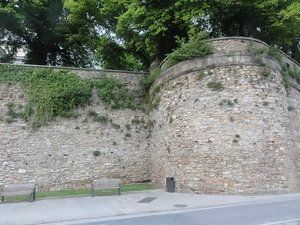Advertisement
Published: June 17th 2013

 First Impression
First Impression
When you first see the wall the large number and size of the towers is quite impressive.We have been talking about visiting this town since we first heard about it while in Cangas, but just hadn’t been able to make good connections. It turned out to be a 1 ½ hour train ride from A Coruna to Lugo (9.40 euro one way) through beautiful countryside. Fortunately we picked one of the rare completely sunny days for our visit. The highlight of Lugo is that it is the only city in Europe with a completely intact Roman wall. It was built between 265 AD and 310 AD. The city itself is the oldest in Galicia since it was founded in 15 BC. The total length of the wall is 1 ½ miles and varies between 8-12 meters (26-39 feet) thick and at its tallest point it was 35 feet. Over the centuries there have been repairs and modifications with an additional 5 gates added to the original 5. It contained 85 towers and has several access points to the top of the wall. The top of the wall has become a favorite for runners, joggers and tourists. It was amazing to stand on top of something that had been built almost 2 centuries ago. We had time while

 The Walk On Top of the Wall
The Walk On Top of the Wall
The 1 ½ mile walkway on top of the Roman city wall is well used by walkers, joggers, runners and of course tourists. there to visit two museums. They provided an excellent history of the Roman occupation describing the building of the wall as well as how and why it has changed over the centuries. The provincial museum is housed in the former monastery of San (Saint) Francisco and contains a variety of exhibits. Seeing the cloister, numerous sundials, and architectural details of the monastery complete with its kitchen area, we were able to view works of many Galician artists throughout the ages – this included sculpture, paintings, jewelry and pottery. For the rest of the day we took time to walk the perimeter of the city from the top of the wall, explore the city streets and visit the Cathedral which was built in 1129. We caught the 5:30PM train back to A Coruna after a very enjoyable visit to Lugo. If you are ever in the area, we would recommend putting this on your list of places to visit.
Advertisement
Tot: 0.237s; Tpl: 0.012s; cc: 12; qc: 28; dbt: 0.2069s; 1; m:domysql w:travelblog (10.17.0.13); sld: 1;
; mem: 1.1mb

 First Impression
First Impression
 The Walk On Top of the Wall
The Walk On Top of the Wall




































